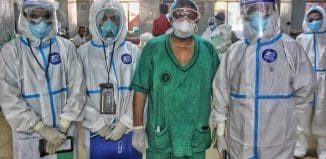North Korea Demonstrates Submerged Ballistic Missile Launch
This post is also available in:  עברית (Hebrew)
עברית (Hebrew)

North Korea claims to have successfully launched a ballistic missile from a submarine beneath waters off the coast of its mainland. That missile has the exact characteristics of the Russian SS-N-6 first generation submarine ballistic missile that has a range of 1,500 miles, carrying a reentry payload of 1,400 pounds with a circular error probability of a little over a half mile.
The Soviet Union has built some 1,800 SS-N-6 missiles, complete with nuclear warheads. Moscow placed them on Yankee Class submarines from the early 1970s through 1990.
The North Korean Strategic demonstration of power projection is not only a remarkable technical breakthrough – it is a game changer. Pyongyang is now capable of survivable and mobile submerged ballistic missile strike platform capability of ranges up to 1,500 miles. With North Korea’s current nuclear inventory exceeds two dozen weapons and with an existing, but not verifiable, ability to miniaturize nuclear warheads. This submerged SS-N-6 capability coupled, with a single nuclear or multiple warheads, provides North Korea with an underwater survivable mobile strategic nuclear platform to project power and to deter power used against them.
Register to iHLS Israel Homeland Security
With this submerged nuclear strategic capability inside of their own waters, North Korea could strike and threaten all of the territory of South Korea as well as Japan and all of its islands. Taking this submerged nuclear ballistic missile capability into international waters, North Korea would have the capability to strike and threaten Guam, Hawaii, Alaska and the Western States of the United States
The missile defense systems of the United States, Korea and Japan deployed in the immediate region will have to adjust. Land based persistent missile defense intercept systems such as THAAD and Aegis Ashore will have to be deployed in Korea, Japan, Hawaii and Guam. Unlike Japan or Korea, Hawaii has an existing Aegis Ashore site used for testing. It could be made operational, capable of defending all of Hawaii from this new North Korean threat.
Current THAAD units stationed in Fort Bliss, Texas could be deployed for a defensive capability to Alaska and the Western States from this threat. In addition to Missile Defense, shielding against this new North Korean threat will have to take into account offensive preemptive first strike, left of launch capabilities and anti-submarine tactics / warfare by the United States and its Allies of the Republic of Korea and Japan.
Written by Riki Ellison, Chairman and Founder, Missile Defense Advocacy Alliance.






























